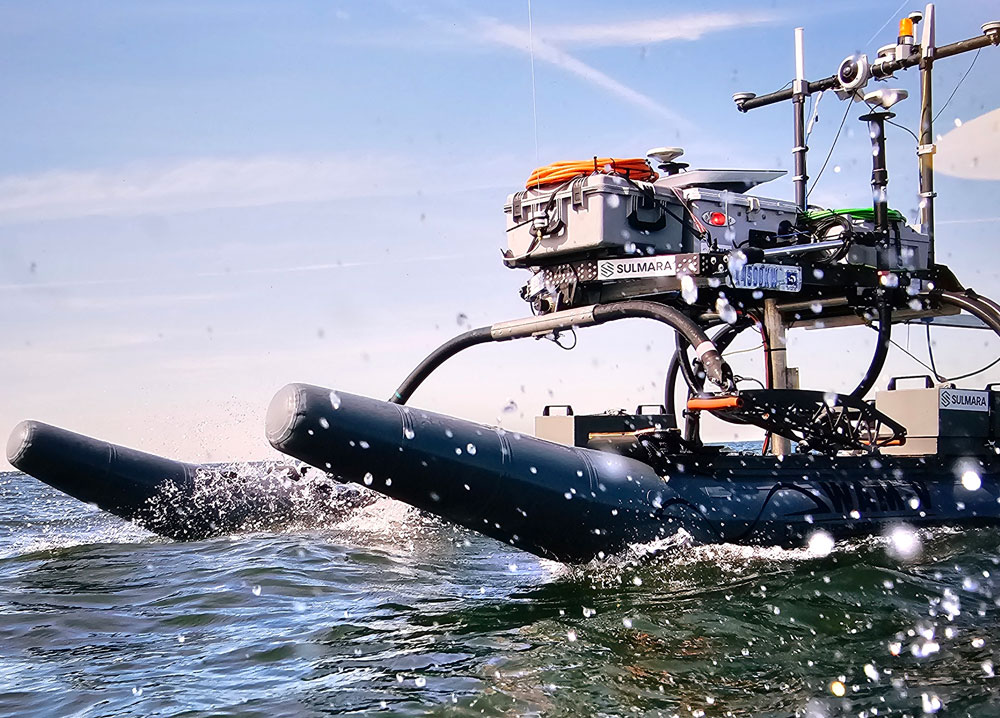With its projected value of US$4.05 billion by 2050, it’s easy to see why the ‘blue economy’ is spawning a race to deliver smarter, safer and more efficient ways to monitor our oceans, writes Matthew Ratsey.
The offshore renewables sector (wind, tide, wave and thermal) is growing to augment, and potentially replace, existing hydrocarbon energy production. According to a report by Wood Mackenzie, global offshore wind capacity alone is projected to increase from 34GW to 330GW over the next 10 years, driving the installation of more than 80,000 new fixed or floating moored turbines. Each of these will require accurate seafloor data for the life of their installation, potentially for up to 30 years.
The marine survey and mapping industry is set to remain in rude health for some years to come. Additionally, many other sectors require hydrographic and geophysical surveying, including seabed extraction, utilities, biotechnology, telecoms and subsea wrecks.
Crewed or uncrewed?
Traditionally, marine surveying has relied heavily on crewed vessels for sensor deployment/recovery and data collection. The complexity of these tasks, combined with physically challenging environments, might lead one to rule out USVs – yet the opposite is true, as autonomy proves itself increasingly capable of boosting productivity, safety and economy of physical, financial and human resources.
As with all disruptive technologies, the true extent and potential of autonomy in the survey industry is still being revealed, and this will continue as new systems, along with AI and machine learning, enable more human-dependent processes to be completed by machines. The barriers to operating over-the-horizon USVs for offshore hydrographic and geophysical surveys are rapidly being overcome. Regulatory codes of practice are being adapted and developed, while forward-thinking manufacturers are coming up with technical solutions on a pathway to ever greater autonomy and efficiency.
My own company, Zero USV, has been at the forefront of this against the backdrop of what already exists on the market: vessels operated substantially, or only, by remote control from the shore. This is not the same as a vessel that’s independently capable of maintaining its operational functionality in the absence of any form of connectivity, while also avoiding shipping, marine mammals and other obstacles.
Break with tradition
Advances in graphic processor unit (GPU) technology over the past few years have enabled AI software to be deployed ‘on the edge’, meaning the AI models can be deployed on physically small GPUs, mounted on the boat. These are roughly the size of an A5 box, with low electrical consumption, but extremely powerful. This is the step change in chip technology led by NVIDIA, which three years ago would still have required a server rack level installation. The edge compute devices with the AI models installed on board ensure enough intelligence is built into the vessel to be able to carry out missions without having to rely on, or constantly revert to, an ‘always-on’ satellite connection.
While some may argue that USV use is restricted to areas away from structural or geophysical ‘hazards’, I’d strongly argue that this isn’t the case given advances in AI and connectivity technology, particularly in providing robust communications ‘over the horizon’. With the ushering in of low earth orbit (LEO) satellites such as Starlink, and hybrid connectivity solutions which bond multiple bearers (4G, LTE, satellite, etc) hitting the market, autonomous navigation and edge collation of survey data are becoming much less of an issue.
AI benefits
Extensive R&D, innovation, robust engineering and planning will help to overcome the physical challenges associated with autonomy in marine surveying, including towing. AI is emerging as the real game-changer. With AI, survey companies can automate and optimise speed, in addition to immediate-course and whole-voyage routing for fuel optimisation and vessel safety. Commercial performance and resultant job security will follow quickly. AI promises immediate improvements to marine data acquisition and comes at a time when scarcity and cost of human skills and experience are significant factors.
That AI will increase job security at a time when skilled resource is low – partly down to the rapid growth of offshore wind, discussed above – is another story for another day, and one I’ll not go into here. However, the appetite for AI and uncrewed surveying is growing. AI will not replace skilled surveyors but will help to streamline operations and the collation of accurate data, and ultimately reduce human error and risk. Furthermore, with AI, survey companies are ingesting data the entire time and, whether it is object data from the computer vision (CV) system or the data from the radars and AIS, all of it can be used to train the AI datasets for improvements in the field.
By dint of their much lighter payload (no crew with all their attendant food, water and accommodation needs), USVs help to reduce carbon emissions, so they are greener. USVs can also work in pairs or even fleets, looking out for out each other, or in tandem with crewed vessels if needs be. Whatever the future, get ready for more computers to take the helm of survey vessels.
Matthew Ratsey is managing director of uncrewed vessel charter firm Zero USV




